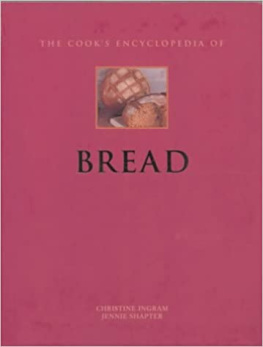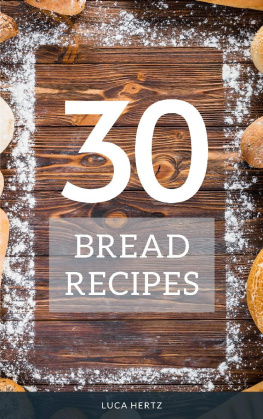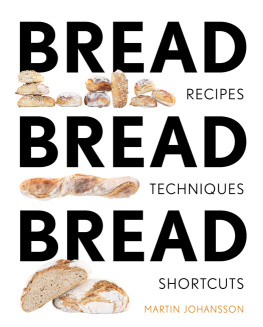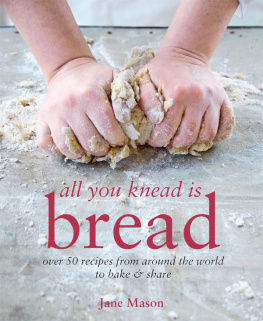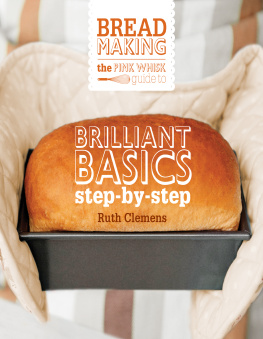Christine Ingram - The Cooks Encyclopedia of Bread
Here you can read online Christine Ingram - The Cooks Encyclopedia of Bread full text of the book (entire story) in english for free. Download pdf and epub, get meaning, cover and reviews about this ebook. year: 2000, publisher: Lorenz Books (2000), genre: Home and family. Description of the work, (preface) as well as reviews are available. Best literature library LitArk.com created for fans of good reading and offers a wide selection of genres:
Romance novel
Science fiction
Adventure
Detective
Science
History
Home and family
Prose
Art
Politics
Computer
Non-fiction
Religion
Business
Children
Humor
Choose a favorite category and find really read worthwhile books. Enjoy immersion in the world of imagination, feel the emotions of the characters or learn something new for yourself, make an fascinating discovery.
- Book:The Cooks Encyclopedia of Bread
- Author:
- Publisher:Lorenz Books (2000)
- Genre:
- Year:2000
- Rating:3 / 5
- Favourites:Add to favourites
- Your mark:
- 60
- 1
- 2
- 3
- 4
- 5
The Cooks Encyclopedia of Bread: summary, description and annotation
We offer to read an annotation, description, summary or preface (depends on what the author of the book "The Cooks Encyclopedia of Bread" wrote himself). If you haven't found the necessary information about the book — write in the comments, we will try to find it.
The Cooks Encyclopedia of Bread — read online for free the complete book (whole text) full work
Below is the text of the book, divided by pages. System saving the place of the last page read, allows you to conveniently read the book "The Cooks Encyclopedia of Bread" online for free, without having to search again every time where you left off. Put a bookmark, and you can go to the page where you finished reading at any time.
Font size:
Interval:
Bookmark:
THE COOK S ENCYCLOPEDIA OF ~\ jtL &~- .... ^v:^r - AD CHRISTINE INGRAM JENNIE SHAPTER
THE COOK'S ENCYCLOPEDIA OF BREAD v ft**' * .* * - .li t ' \ * - ' * . ^f^p * V ^ r
**. ** w W- -s m
THE COOK'S ENCYCLOPEDIA OF BREAD \t ji '~; ,-. ** ,^ A V.fi. CHRISTINE INGRAM JENNIE SHAPTER Barnes 8vNoble BOOKS NEW YORK
-1. ^-"^ **n&?z This edition published by Barnes & Noble, Inc., by arrangement with Anness Publishing Limited 2000 Barnes & Noble Books M 10 98765432 1 ISBN 0-7607-2076-2 All rights leserved. No part of this publication may be reproduced, stored in a retrieval system, or transmitted in any way or by any means, electronic, mechanical, photocopying, recording or otherwise, without the prior written permission of the copyright holder. Publisher: Joanna Lorenz Executive Editor: Linda Fraser Editors: Janet Charatan, Jo Lethaby and Jenni Fleetwood Designer: Nigel Partridge Photographers: Nicki Dowey (recipes) and Amanda Heywood Home Economists: Jennie Shapter (recipes) and Jill Jones Editorial Reader: Catherine Sillence Production Controller: Don Campaniello Originally published as The World Encyclopedia of Bread and Bread Making Printed and bound in Hong Kong Anness Publishing Limited 1999 Updated 2000
Contents INTRODUCTION 6 History 10 Grains and Milling 12 Ingredients for Bread Making 14 Techniques 22 Bre \d-making Machines 32 Bread-making Equipment 33 BREADS OF THE WORLD 38 British Breads 40 French Breads 58 Belgian Breads 65 "~-\lian Breads 66 ^"axish Breads 72 rtuguese Breads 74 "erman Breads 76 -ch Breads 81 - -s Breads 82 \ "jdic Breads 85 T. --=tern European and Russian Breads 90 f:' " - 3 ' *%& , :" * ~" S . 'it- -'-V **; ***** L 0 i\ \ The Breads of Greece, Cyprus and Turkey 94 The Breads of the Middle East and North Africa 98 Jewish Breads 100 Breads of the Americas 104 Caribbean and Mexican Breads 116 Hawaiian Breads 117 Indian Breads 118 Australian Breads 120 Chinese Breads 123 Japanese Breads 124 South-east Asian Breads 125 BREAD RECIPES OF THE WORLD 126 British Breads 128 French Breads 152 Mediterranean Breads 168 North European and Scandinavian Breads 196 Breads of the Americas 220 Breads of India and the Middle East 236 Shopping for Bread and Flour 250 Index 252
INTRODUCTION There is something undeniably special about bread. The flavor of a good loaf, the texture of the soft crumb contrasting with the crispness of the crust, is almost a sensual experience. Who can walk home with a fresh baguette without slowly, almost absent-mindedly breaking off pieces to eat en route? Or resist the promise of a slice of a soft white farm- . house loaf, spread simply with butter? Most people have their own favorite: ciabatta, rich with olive oil; dark, malty rye; honeyed challaJi or a Middle Eastern bread, freshly baked and redolent of herbs and spices. Whatever the shape or texture, bread has a special place in our affections. Even today, at the turn of the century, when bread is taken largely for granted, seen as an accompaniment or a "carrier" for other foods, we still have a sense of its supreme significance. In some languages the word "bread" means "food," and in certain of the more rural parts of Spain and Italy, for example, you may find that bread is blessed or kissed before being broken or eaten. There are numerous rituals and traditions attached to bread. Slashing the dough with a cross or making a sign of the cross over the loaf before baking was believed to let the devil out. Cutting the bread at both ends was also recommended to rid the house of the devil. One extraordinary custom was sin-eating, a practice at funerals, where someone Below: Cutting a cross in an unbaked loaf was believed to let the devil out. meal, with or instead of potatoes or rice, is catching on, but sandwiches are probably still the favorite way of enjoying bread. Sandwiches have been going strong for a couple of hundred yearsinvented, it is said, by John Montagu, 4th Earl of Sandwich, so that he could eat a meal without having to leave the gaming table. "^ h Although baguettes and bagels are nat- ** \ urafly suited for linking bread with i'f J meat, the sandwich, clearly an English '"-V concept, is unique and continues to be the perfect vehicle for fillings that become more and more adventurous. Above: Just a few of the many shapes and types of bread. would eat a loaf of bread and by so doing would take on the sins of the dead person. The obvious explanation for bread's importance is that until quite recently, it was for many, quite literally the "staff of life"the single essential food. Today, most people have more varied diets. Potatoes, pasta and rice are all enjoyed in the West and are important staple foods, but in some countries, France and Italy, for example, bread is easily the most popular of the carbohydrates, eaten with every meal and in many cases with every course. Like wine tasters, true aficionados taste bread au naturel in order to savor its unique taste and texture, unadulterated by other flavors. Good as plain bread can be, the best thing about bread is that it goes so well with other foods. Throughout Europe bread is most frequently cut or broken into pieces to be eaten with a mealto mop up soups and sauces or to eat with hams, pates and cheese. Dark rye breads, spread with strongly-flavored cheese or topped with smoked fish, are popular in northern Europe, and in the Middle East breads are split and stuffed with meats and saladsa tradition that has been warmly embraced in the West too. In Britain and the United States, the European custom of serving bread with a Breads of Today Figures show that throughout Europe bread consumption declined after World War II. Until then it was the single most important food in the diet, but due to increased prosperity, which meant a wider choice of other foods, and mass production, which led to bread becoming increasingly insipid and tasteless, people moved away from their "daily bread." The situation was more noticeable in some countries than others. In France, Italy and Spain, where people continued to demand the best, bread consumption did not. decline so sharply, although even in these countries, the quality did deteriorate for a time. In Britain, however, most bread was notoriously blandthe ubiquitous Below: In northern Europe, dark rye bread is served sliced with colorful, rich-tasting toppings.
INTRODUCTION "e sliced loaf being little more than a -anient shape for the toaster. In supersets, certainly, there was a time, not ing ago, when other than the standard _ wrapped white loaf, the only baked _ ds on sale were croissants and a selec- of fruited teabreads, vaguely labeled ""Continental." Yet within the last ten t -s- things have improved by leaps and _ids. Perhaps supermarkets, finding the smell of freshly baking bread - ~ ed shoppers into their stores, billed more in-store bakeries. Or per- s shoppers who traveled abroad and sr-fled the breads of other countries cre- -i a demand for better breads made h better flours, using more imaginative - " es and untreated with additives. Nowadays there is a wide variety of -=-ds available both from independent ries and large supermarkets. Italian -rta and focaccia are now a regular _. * even in the smallest food stores, as -- various Spanish, Indian and Middle E -=m breads. There is an increasingly _ variety of German, Danish, - jidinavian and Eastern European lads and, among the French breads, " - J is now a truly good range. If the - _ Tnarket has an in-store bakery, _r_T"tes are likely to be freshly baked, same are now as good as the real The availability of pain de cam- _*. levains and other rustic breads _ is that you can choose breads to suit - -~Ie of meal you are serving, while - "=" breads, such as brioches and crois- = from France, pane al cioccolato ~ Italy and numerous offerings from ^rnany. mean that there is much more se from than simply toast at break- "id rolls with dinner. ca! bakers, although competing with supermarkets, have paradoxically zred from the range available at =nnarkets. The more breads there are , t. e. the more people feel inclined to - ~i-r baked goods. Small bakers who have easily lost customers to the - s. have risen to the challenge by jig their own range of country- I ar.d fine breads. Craft bakers are _ng traditional breads, at the same Above: A huge range of traditionally baked French breads are offered for sale at this specialty bakery. time experimenting with recipes they have devised themselves. Bread making has never been a tradition that stood still. The best craft bakers have ensured that bread making has continued to evolve, resulting in the emergence of all kinds of corn and barley breads, mixed grain loaves and a range of new sourdoughs. Added to this are the many European- style bakeries. Set up and run by emigres from all parts of Europe and beyond, these bakeries are the best source of many of the most authentic European breads. In supermarkets you will invariably find ciabatta or focaccia, but for Below: Traditional country-style breads are enjoying a renaissance. paesano, pagnotta or pane sciocco you are likely to need an Italian baker, who will be only too happy to provide you with the loaves and tell you all about them while they are being wrapped. Once you have found a bakery you like, there are no particular tips for buying bread; the baker will be pleased to explain the different styles of loaves and advise on their keeping qualities. Crusty breads, such as baguettes and Italian country loaves are known as "oven bottom" or "oven bottom- baked," which means they have been baked, without pans or containers, on the bottom of the oven or on flat baking sheets or stones. They are evenly crusty, although the type of dough, the humidity during proving, the steam in the oven and the heat itself determines whether the crust is fragile or chewy. Loaves such as the English farmhouse ones, baked in metal pans, characteristically have a golden top, but with thinner crust on the sides. Rolls or breads baked packed up against each other have even softer sides and are described as "batch-baked." Sourdough breads are made without yeast using a natural leaven insteadand are often labeled as "yeast-free" breads or "naturally leavened." There are many varieties, some made entirely from wheat, some from rye, others from a blend of both of these or other grains. They are normally heavier than an average loaf, with a dense texture and pleasantly tart flavor.
Next pageFont size:
Interval:
Bookmark:
Similar books «The Cooks Encyclopedia of Bread»
Look at similar books to The Cooks Encyclopedia of Bread. We have selected literature similar in name and meaning in the hope of providing readers with more options to find new, interesting, not yet read works.
Discussion, reviews of the book The Cooks Encyclopedia of Bread and just readers' own opinions. Leave your comments, write what you think about the work, its meaning or the main characters. Specify what exactly you liked and what you didn't like, and why you think so.

